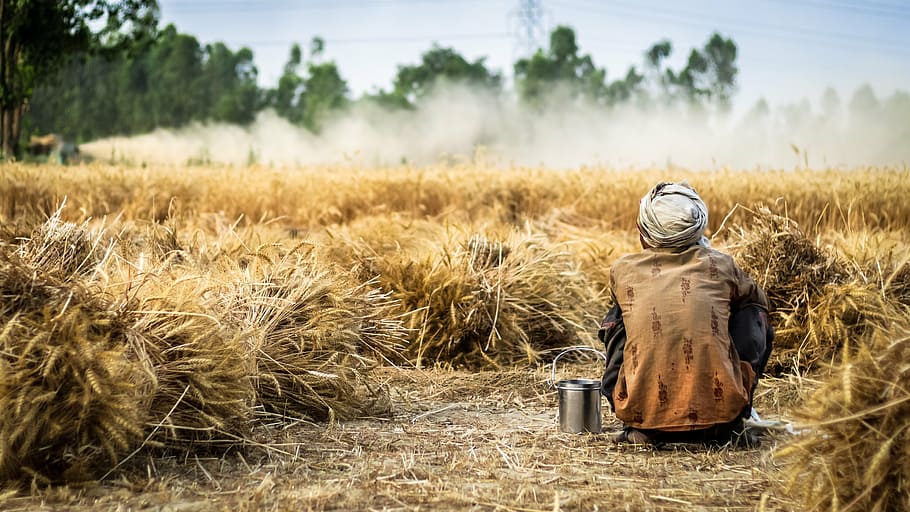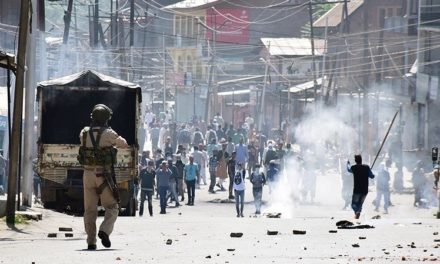29 April 2020
The COVID-19 pandemic has resulted in an unprecedented health crisis world-over, where we are still grappling with the unknown characteristics of the virus. This is also an economic crisis of such scale that many wonder whether the world economy will ever revive back to its pre pandemic days. This health crisis has laid bare the fissures of the neoliberal economic regime and the widening inequalities of the last three decades of its domination. The health crisis has acted upon these pre existing inequalities and made it more brutal for those belonging to the marginalized classes, social groups and gender. This article looks particularly at the impact of the pandemic and resultant lockdown on migrant agricultural workers, the most deprived of the rural society in India.
The response of the right wing Indian government to announce a nationwide lockdown has been dubbed amongst the most stringent across the world. However, in comparison the accompanying economic package and other measures of food security to ameliorate the conditions of the most deprived sections of the country in this period of near complete stalling of productive activities has been piteous. The ensuing humanitarian crisis and desperate conditions of the working class is inevitably leading many to take the difficult choice between a health risk and dying out of starvation.
The population of 100 million internal migrant workers, who are estimated to form 20 per cent of India’s workforce, have been the worst sufferers in the unplanned lockdown that started on March 25.[1] They have been stranded in the cities and other locations of work, without wages, money and food.[2] The images of migrant workers walking hundreds of kilometres to reach their villages during the lockdown brought this otherwise invisibilised population under public eye.
The Indian statistical datasets have been inefficient in capturing actual extent of short term circular migration. Therefore, the estimations of worker population migrating for different occupations have largely remained under-reported. However, there have been definitive trends of increasing number of internal migrants moving from rural to urban areas for work between the decadal census findings of 2001 and 2011. Studies using railway data found that between 2011-2016, an average of nine million workers undertook interstate travel.[3] This trend has been directly commensurable with the heightened agrarian crisis in the countryside, which has been marked by falling farm incomes and increasing indebtedness whose most disturbing ramification although not a robust measure has been a sharp rise in incidences of farmer suicides.
Among the various categories of migrant labourers in India, one category is of the seasonal workers employed in agriculture and related activities. Data shows that the agricultural labourers, who take upon rural to rural inter district and interstate seasonal migration, predominantly belong to the Scheduled Caste and Scheduled Tribe categories, making them one of the most deprived strata of the rural hierarchy.[4] With their mobility restricted this very section faces one of the greatest brunt of the pandemic lockdown.
In order to fully gauge the harshness of the blow that has befallen on these agricultural labouring classes, the pandemic has to be situated within the context of the pre COVID-19 economic conditions. The COVID-19 pandemic crisis comes at a time when the Indian economy was already reeling under an extended period of stagnation, and fall in demand. The slump in consumption was most evident in rural India in the months leading up to the pandemic, all through last year with the same trend continuing well into this year, showing no signs of recovery. This demand crisis has been attributed prominently to the fall in days of employment available to manual workers along with a slowing down of the wage rates. Research shows that real wage growth for rural labourers plunged from 14.6 per cent in 2014 to a mere 1.1 per cent in 2019. Women labourers fared even worse receiving four fifths of the wages that were paid out to men in the harvest and post harvest agricultural operations.[5]
Under such conditions, the present agricultural season was even more crucial for the rural workers to fight their daily battles of hunger and destitution. Village studies have come to show that in the Indian countryside there no longer exists a pure class of agricultural labourers as a result of declining days of employment available in agriculture. However, there is a class which can be classified as manual workers, who shift from seasonal agricultural work to non-farm manual work in the lean season. It is this same class that the migrant agricultural workers belong.
When the nationwide lockdown was announced in India, while the rain-fed regions of the country did not have standing crops, the regions endowed with irrigation facilities either had standing crops of wheat, vegetables, oilseeds or pulses ready to be harvested.[6] The regional variation in the cropping pattern as a result of the disparity in development of agricultural systems and wage rates contributes towards the movement of migrant agricultural labourers in search of employment. In the northern states of Punjab and Haryana it is a busy season of wheat harvesting, which employs big numbers of migrant labourers from the eastern states of Bihar and Jharkhand who are employed in both the field operations as well as the loading and unloading activities at the government run procurement centres. It is estimated that Punjab involves one million migrant workers and Haryana about 0.6 million workers during this rabi season, of whom belong to the state of Bihar.[7] In the wake of this pandemic on the one hand there has been a shortage of labour in these northern states to carry out harvest and post harvest operations, while on the other hand in the states from where the workers could not migrate the agricultural wages have fallen due to oversupply of labour. The migrant workers in their home states have also been adversely affected by the absence of all non farm work during this period of lockdown.
Some migrant workers although had been able to travel to different states for work. The shameful death of a twelve year old tribal girl, Jamla Makhdam due to exhaustion, as she walked for three days to her home state Chhattisgarh has thrown some light on the multitude of deprivation that the migrant agricultural workers have to suffer. Jamla had migrated to Telangana state as an agricultural worker to harvest chillies along with others from her village. Child labour continues as a result of the abject poverty of the families and communities they belong to, as well as the caste ridden vision of policy makers. The Census of 2011 reported the presence of 10 million child labourers in India, of whom 62 per cent were employed in agriculture.[8]
The despicable work and living conditions that the migrant agricultural labourers are subject to are not unique to India. This pandemic crisis has made the policy makers confront with the essential work of the migrant farmhands who keep agricultural production running. The Food and Agriculture Organisation noted in one of its policy briefs, “Migrants play a substantial role in the agri-food systems. Measures affecting the movement of people (internally and internationally) and resulting labour shortages will have an impact on agricultural value chains, affecting food availability and market prices globally.”[9]
The United Kingdom in order to meet the challenge of labour scarcity of migrant Romanian workers on its fruit and vegetable fields, called for applications of farm workers from its own people. However, that experiment seems to have failed as farmers have been forced to admit the skilled nature of agricultural work. A farmer was quoted saying, “They’re quite physical jobs. They’re repetitive. It means working outside in all weathers. You do, for most of the jobs, need a good standard of manual dexterity meaning you can use both hands at the same speed.”[10]
Many other western countries dependent on an inflow of migrant farm workers from Mexico, Eastern Europe and Africa to run their agricultural production have provided relaxations for their movement. However, there has been a lack of adequate measures to ensure safety of the health of these vulnerable sections of workers. The IUF (International Union of Food, Agricultural, Hotel, Restaurant, Catering, Tobacco and Allied Workers’ Associations), in its charter of demands on agriculture has highlighted the precarious working conditions of these farmhands. On the one hand closure of borders has taken away their major source of livelihoods, while those already working on different farms in the countryside lack essential access to public health. The IUF statement notes that only ‘5 per cent of workers in agriculture have any access to a labour inspection system or legal protection of their health and safety rights.’
The All India Agricultural Workers Union (AIAWU), with the largest membership of agricultural workers in India, has also put out a set of demands to ameliorate the conditions of agricultural workers during the period of the COVID lockdown. The union has stressed on government provisioning of food rations covering all sections of the rural working class population at a time when these people are out of work, and incomes to buy their own food. The AIAWU has demanded that the government should assist in generating employment and issue timely wages under the Mahatma Gandhi National Rural Employment Scheme (MGNREGS), which was legislated under the Rural Employment Guarantee Act in 2005 to provide up-to hundred days of employment to all rural households. However, over the years the scheme has suffered as a result of budgetary cuts. In this period of the pandemic crisis, revival of the scheme would be crucial to generate employment and demand in rural India, where otherwise all other non-farm activities are presently stalled and movements restricted.
Talking over a telephonic interview, Vikram Singh, Joint Secretary of the AIAWU expressed concerns over the directives of the Ministry of Agriculture for the next agricultural season, which emphasises mechanised farm operations, to keep the norms of physical distancing in place. There are reports to suggest that states like Punjab are already making efforts to bring a shift in the cropping pattern from the usual rice cultivation to maize for its greater mechanized operations.[11] Reports from villages also inform that due to the restrictions on labour movement under lockdown, farmers were compelled to carry out mechanized harvesting operations to save their crop yields.[12] At a time when rural farm workers are grappling with loss of livelihoods, a greater shift towards mechanized operations can act as a further deterrent to the possibilities of finding work in the near future. Although, only time will tell how well founded these concerns are.
Historian David Arnold, wrote on the sparsely recorded history of the 1919 Spanish Flu, considered as the last biggest pandemic to have struck India taking away millions of lives. He commented on the inability and conspicuous absence of the colonial state to provide relief especially to the poorer sections of society.[13] Since the 1919 Flu, India has attained independence and there have been leaps in scientific advances made. However, in the management of the present crisis by the central government one finds a striking similarity in terms of a general absence of sensitivity towards the health and livelihood concerns of the working class majority.
Therefore, it is time, more than ever, for building solidarities to push for a working class driven agenda for tackling this pandemic crisis and beyond. The agricultural workers of the third world form one of the largest sections who are being dispossessed of their health, and livelihoods. Although at present their voices may sound feeble due to the starved bellies.
*is Policy Researcher with Focus on the Global South and based in New Delhi, India
[1] Estimates based on 2016-17 Economic Review published by the Government of India
[2] https://covid19socialsecurity.files.wordpress.com/2020/05/32-days-and-counting_swan.pdf
[3] The Cohort based Migration Metric was presented in the Economic Review 2016-17
[4] 35 per cent of the ST males migrating to other states were involved in the primary sector, the same was 23 per cent for Scheduled Caste and only 13 per cent for other caste groups (http://mohua.gov.in/upload/uploadfiles/files/1566.pdf, estimations based on National Sample Survey 2007-8)
[5] https://www.newsclick.in/Slump-in-Market-Economic-Slowdown-Nirmala-Sitharaman
[6] See report of the Foundation for Agrarian Studies who conducted a rapid assessment survey to study the impact of Covid lockdown across 21 villages of India. The study highlights the regional variations and differences across agrarian classes in the impact of the pandemic on count of three components of health, household incomes and government provisioning. It can be read at : https://frontline.thehindu.com/cover-story/article31404299.ece
[7] https://www.cmie.com/kommon/bin/sr.php?kall=warticle&dt=2020-04-24%2013:42:02&msec=043
[8] https://www.livemint.com/politics/news/where-is-child-labour-most-common-in-india-1549906952167.html
[9] Food and Agriculture Organisation (2020), Migrant workers and the Covid-19 pandemic
[10] https://www.dailymail.co.uk/news/article-8280077/Theyre-deluded-Farmer-took-50-English-workers-pick-crops-just-7-left.html
[11] https://www.business-standard.com/article/economy-policy/labour-issues-punjab-to-promote-maize-cultivation-in-coming-kharif-season-120041900798_1.html
[12] https://www.vikalp.ind.in/2020/05/impact-of-covid-19-on-agricultural.html
[13] Arnold, David (2019), “Death and the Modern Empire: The 1918-19 Influenza Epidemic in India”, Transactions of the RHS, Volume 29, pp 181-200










